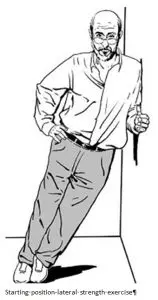Quick & Fun Balance Training
A couple months ago I noted a few leaders who have stumbled, fallen and hurt themselves to one degree or other. See “Don’t Fall… in Line with Leaders.” We visited the dozen dangers to avoid those slips and falls.
Those leaders are famous, we may not be. We still want to learn to circumvent those risks that led to such down-falls. I admit, and am sure you agree, that it isn’t always possible to catch ourselves from falling. Although there are keys to ‘better falling,’ we won’t cover that here. Instead, our focus is how best to reduce frequency and severity.
It is never too early to start balance training in life. You can consider the examples in this post as ones with which to begin. I recognize they aren’t the only ones. Still, they are a few of my favorites.
Each of these is time efficient, effective and inexpensive. Readers of Aging_with_Pizzazz know I like the low-hanging fruit concept. Try at least one of these tips, or perhaps all, to easily benefit your balance.
One-Leg Balance
While waiting for the tea water to boil, the coffee to brew or perhaps brushing teeth, balance on one leg for 20-30 seconds. Switch. Do each side to the same height, and for an equal number of seconds. Everyone has at least THIS much time.
Start or Continue to use PizzazzEE-25
I would be remiss in not suggesting my own program (PizzazzEE-25), developed especially for balance, stamina and flexibility.
Systemic stretching is excellent
for balancing body muscles,
…and for helping to establish better balance.
Gym Ball Sitting
Use an Exercise ball for watching the news or a short program. Additionally, it has other advantages for muscles aside from balance. If you are purchasing one, make sure it is a “gym” or “Yoga” ball of the right size for you, and not a tiny “Pilates’s ball” used for other purposes. Tip: When purchasing, 35 cm balls are best for those folks under 4.2′ tall, 85 and 90 cm balls are for those over 6.5’ tall. For example, at 5.4′, I use a 45 cm ball. There are only a handful of sizing options.
Breathalyzer Walk
Walk approximately 20 steps by placing the heel to toe along an imaginary tight rope. If you have room, do it in a straight line. I have a wooden floor that allows me to do this along its slats for about 17-18 easy steps (without walking into anything). Even without a drink, you may find it more difficult than you expected. If you reach step 8 or 9 without swaying off to the side, good going – and keep going.
Good-Form Squats
See “Exercise Your Squatters Rights” for both form and benefits. Squats are weightlifting and strengthening activity. I incorporate them into many of my personal routines. I also take my own advice regularly and remember that the kitchen is a useful area to replace a bend with a squat. Don’t believe me? Take notice of how often you bend over for items while cooking or putting away pots and pans.
Door Jam Lean
Also called a Lateral Strength Exercise, a door-jam lean strengths muscles that then support balance to avoid tumbles. A few times a week (or more) when you walk through a door opening, performing this action will help avoid other problems of imbalance and awkward mobility.
 Specifically important to our standing balance is how far apart we can spread out our legs (this is a lateral movement – to the side) and how far we can do it with good muscular power. Unsuspected by most people, when we walk it’s the muscle in the opposite hip from motion that is stimulated to maintain our controlled movement.
Specifically important to our standing balance is how far apart we can spread out our legs (this is a lateral movement – to the side) and how far we can do it with good muscular power. Unsuspected by most people, when we walk it’s the muscle in the opposite hip from motion that is stimulated to maintain our controlled movement.
These activated muscles are the source of our power or strength to perform the lateral (wide) stance.
As we age, we sometimes lose our confidence in both our range of motion (ROM) and our strength, especially of hip/leg/back muscles. When you see an older person shuffling along, who is otherwise healthy and non-arthritic, it is often due to the relationship of strength – ROM – and Confidence as seen in our previous post. Graphic far below.
That being said, to improve our own ability, (or maintain what we have if it’s already fairly good), the quick and easy door-jam lean can be done just walking from one room to another.
Remember (as with many of our exercises), it is important to do it bilaterally. Like eating a hamburger (which I no longer enjoy), you’re not ready until both sides are done.
Directions shared here are simple. Let’s restate that, the lean is simple, the directions not as much. It takes longer to read about it than to do.
—
Door Jam Lean
1.) Stand next to wall or centered within a doorway and lean on the jam with your shoulder.
2.) Move your feet out sideways as far as you feel comfortable, feet together (not crossed), legs straight.
3.) Push upper hip out (may seem slightly up) away from wall or jam. Hold briefly.
4.) Bring that hip (currently sticking out) back and then closer to wall or door jam. Repeat steps 3 & 4 several times.
5.) When feeling solid, with feet in the same position and your hips straight, lift outer leg up and straight out to side. Hold briefly. Return and repeat several times.
6.) Reverse and preform equal number on the other side.
A doorway often feels more secure than the wall, but make sure you pick a wide enough doorway to allow your best work. You should feel the effort of this movement in the hip closest to wall / door jam – opposite the leg being raised.
Final Thought
Avoiding the Baker’s Dozen Dangers from the previous post and incorporating the half-dozen tips for balance ‘training’ here offers more than just improved steadiness on our feet. It stimulates all-around better health.
Totally deflecting the problems accumulated from poor biomechanics requires effort to be sure. But I trust we would all like to prevent those imbalances as well as aches and/or pains for as long as possible.
Our body mechanics are ubiquitous in our everyday life. Concerns about function are worthy of our notice as are the efforts to improve that function. Balance is key. With good biomechanics, risks and negative effects can be so drastically reduced as to have little (instead of catastrophic) consequence from events such as slips and trips.
If we increase the elements of our balance, strength and flexible ROM (range of motion), we will increase our confidence over the dreaded fear of falls and unsteady movement. It’s a cost-effective way to improve our long-term well-being, ensuring that we Age with Pizzazz.
—
Reference: CDC program STEADI, standing for Stopping Elderly Accidents, Death and Injuries. (More for providers and treatment options) STEADI – Older Adult Fall Prevention | CDC; Evaluation Guide for Older Adult Clinical Fall Prevention Programs cdc_78041_DS1.pdf
 Resource Algorithm for Fall Risk Screening, Assessment, and Intervention (cdc.gov)
Resource Algorithm for Fall Risk Screening, Assessment, and Intervention (cdc.gov)
—
Title Picture and Graphics: drb
The post Quick & Fun Balance Training appeared first on Aging with Pizzazz.























